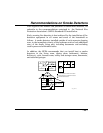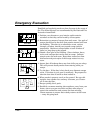
– 27 –
System Limitations
While this system is an advanced-design security system, it does not offer guaranteed protection
against burglary, fire, or other emergency. Any alarm system, whether commercial or
residential, is subject to compromise or failure to warn for a variety of reasons. For example:
• Intruders may gain access through unprotected openings or have the technical sophistication
to bypass an alarm sensor or disconnect an alarm warning device.
• Intrusion detectors (e.g., passive infrared detectors), smoke detectors, and many other sensing
devices will not work without batteries or if the batteries are not put in properly. Devices
powered solely by a main power supply will not work if their main power supply is cut off for
any reason, however briefly.
• Signals sent by wireless transmitters may be blocked or reflected by metal before they reach
the alarm receiver. Even if the signal path has been recently checked during a weekly test,
blockage can occur if a metal object is moved into the path.
• A user may not be able to reach a panic or emergency button quickly enough.
• While smoke detectors have played a key role in reducing residential fire deaths, they may
not activate or provide early warning for a variety of reasons in as many as 35 percent of all
fires. Some of the reasons smoke detectors used in conjunction with the system may not work
are as follows: Smoke detectors may not sense fires that start where smoke cannot reach the
detectors, such as in chimneys, in walls, on roofs, or on the other side of closed doors. Smoke
detectors also may not sense a fire on another level of a residence or building. A second-floor
detector, for example, may not sense a first-floor or basement fire. Moreover, smoke detectors
have sensing limitations. No smoke detector can sense every kind of fire every time. In
general, detectors may not always warn about fires caused by carelessness and safety hazards
like smoking in bed, violent explosions, escaping gas, improper storage of flammable
materials, overloaded electrical circuits, children playing with matches, or arson. Depending
on the nature of the fire and/or the location of the smoke detectors, the detector, even if it
operates as anticipated, may not provide sufficient warning to allow all occupants to escape in
time to prevent injury or death.
• A passive infrared motion detector can detect intrusion only within the designed ranges as
diagrammed in its installation manual. Passive infrared detectors do not provide volumetric
area protection. They do create multiple beams of protection, and intrusion can be detected
only in unobstructed areas covered by the beams. They cannot detect motion or intrusion that
takes place behind walls, ceilings, floors, closed doors, glass partitions, glass doors, or
windows. Mechanical tampering, masking, painting, or spraying of any material on the
mirrors, windows, or any part of the optical system can reduce their detection ability. Passive
infrared detectors sense changes in temperature; however, as the ambient temperature of the
protected area approaches the temperature range of 90º to 104º Fahrenheit (32º to 40º
Celsius), the detection performance can decrease.


















